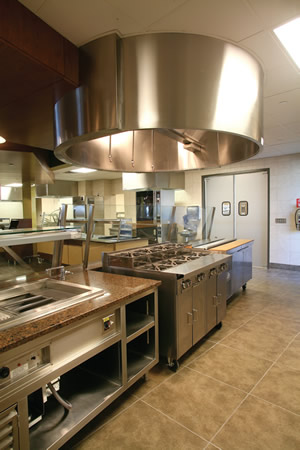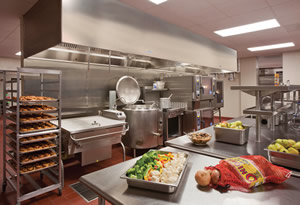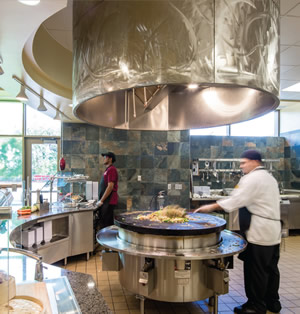Improving IAQ in Your Foodservice Environments

PHOTO COURTESY OF RIPPE ASSOCIATES
Tight maintenance and operations budgets. Priority on classroom and residence hall spaces. These are just some of the reasons foodservice environments are sometimes not given the attention they need, especially in terms of creating and maintaining healthy indoor air quality (IAQ). What, then, are the most important considerations? College Planning & Management recently asked this of Terry L. Pellegrino, FCSI, who has more than 32 years design consulting experience. She is a principal with Rippe Associates, a Minneapolis-based foodservice design consulting firm.
CPM: Why do we care about IAQ in higher education foodservice environments?
Pellegrino: For two reasons. The first is that these environments can be hazardous in terms of things like carbon dioxide emissions and gases we find in such items as propane tanks. The second is that, as a working environment, it’s one of much heat and humidity, and both of those need to be controlled.
There are two groups of people in the foodservice environment. The first is students, who dine with us three meals a day throughout the school year. We don’t want them in an environment that’s not safe and conducive to their well-being. The second is that, in dining, we have a lot of long-term employees who have been with the institution for 25 to 30 years, and we want them to have a good working environment, a safe working environment.
CPM: Do foodservice environments require more care in terms of IAQ than other types of campus spaces?
Pellegrino: The number of air changes in a food service environment is high because the space has a high exhaust requirement. When doing cooking display, the required exhaust levels are even higher. It becomes costly. But it’s very important in the long run because, the better we balance the exhaust and supply, the better the IAQ and the better the operating costs. But, it’s a delicate balance.

PHOTO COURTESY OF RIPPE ASSOCIATES
CPM: What can be done in terms of design to ensure high-quality IAQ in foodservice environments?
Pellegrino: One thing that is mandated today that’s a positive thing is that we have to have sensors in the duct collars of the exhaust hoods. As soon as the sensors sense heat generated by the cooking equipment, they send a signal to turn on the exhaust fans.
Many facilities are grandfathered in and so they don’t need to have sensors. However, as you renovate your foodservice areas, I highly recommend installing them to ensure that the fans turn on and, therefore, heat, smoke, and flue gases get properly exhausted. I find that sometimes employees don’t turn on the fans because they’re noisy or the makeup air is not heated and they don’t want to be colder than they already are.
Another thing to consider is where is the fresh air intake coming from? Because we’re exhausting, we have to pull fresh air in. Sometimes the intake is close to the exhaust and, even though that distance of separation meets code requirements, the site conditions and wind mean that the code separation isn’t adequate. For example, the intake may be located close to a loading dock where semis idle for a long period of time, and the intake pulls in the semi exhaust fumes.
CPM: How does IAQ affect foodservice equipment selection?
Pellegrino: One of the biggest things we do is try to contain equipment within the exhaust hoods so smoke and other negative things don’t drift out from under the hood but are instead kept contained. I advocate that, rather than going with the lowest-cost hood, going with the best-performing. And if we can’t contain with the hoods, then can we look at a choosing a piece of equipment that doesn’t create as much smoke.
CPM: How can administrators be sure that they have good IAQ in their foodservice environments?
Pellegrino: The most important thing they can do is maintain their equipment. I know that, oftentimes in higher education, there’s not funding for repairs because operating budgets are tight. So, maintaining exhaust fans, make-up air units, and cooking equipment is critical. Gas burners need to be maintained to burn at their cleanest, most efficient level, and that’s not always given a lot of attention.

PHOTO COURTESY OF RIPPE ASSOCIATES
TAKING IT ALL IN. Cooking activities generate odors, moisture, food waste, and trash— all of which must be managed carefully to avoid indoor air quality (IAQ) problems. Food odors can be a distraction to students and staff if they circulate through a facility. Ensure local exhaust fans are used while cooking, washing dishes, and cleaning. Noisy exhaust fans may indicate a problem or discourage employees from using them. Also consider the external environment. Because fans exchange air from the kitchen, air from an adjacent loading dock can be drawn into the kitchen. If delivery trucks or other vehicles idle at the dock, exhaust fumes can enter the facility and cause air quality problems. Also, proper placement of waste receptacles prevents odors from entering the building.
The switch in refrigerants from chlorofluorocarbon-reduced to propane is one new thing. There is some concern about propane refrigerants leaks. There’s some concern with it. We’re finding that sizes of the refrigeration systems are limited so any leaks will be small and not pose a risk. But people are obviously concerned about it. And as these new products become more common we’re going to need to be more aware of going forward: where we place compressors, where lines are run, and how to check for leaks. They may also consider leak sensors where they store CO2 tanks for soda dispensers. In general, maintaining equipment and monitoring air handling systems are an important part of making sure things are safe.
CPM: What advice do you most often give higher ed administrators regarding IAQ in their foodservice environments?
Pellegrino: Most often the advice I give is related to the temperature and humidity component of the working environment. I encourage them to look at ways to make sure they have maximum temperatures of 80ºF and not a lot of fluctuation from 40ºF to 90ºF. I encourage them to think about what it’s like to be a staff member having to working a situation that’s like a sauna or a deep freeze. I suggest that there are inexpensive ways to cool the kitchen, such as using transfer air from the dining area, to make sure that the working conditions are reasonable.
Going back to air intake, I do bring that up frequently because it’s something the engineers don’t think about as much as I’d like. For example, after being up and running for three months, I got a call from a campus facility owner that the air from a coffee bean roaster was causing headaches in the staff three floors above the roaster. The fresh air intake was placed the minimum distance from the foodservice exhaust, as required by code, but it was obviously creating a problem three floors up. In this case, we added a retrofit charcoal filter to help. Similarly, a couple of years ago, I encountered a school district that did not have exhaust hoods over a gas convection oven. Someone observed, “Could that be why we always have headaches?” So, you see, it’s the little things that can make a big difference.
This article originally appeared in the College Planning & Management April 2018 issue of Spaces4Learning.